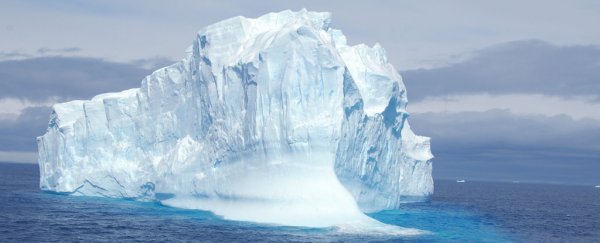Here's another reminder of the precarious position that the world's climate and ecosystems are in: a new study estimates that global warming could push the Antarctic ice sheet past a tipping point in as little as 10 years.
In other words, the point of no return in terms of ice sheet loss is arriving earlier than previously thought, and we may well already be in the midst of it. That could have serious consequences when it comes to sea level rise globally, and the local habitats that animals in Antarctica rely on.
To get a better idea of what's happening right now, the researchers went back into the past, looking at the continent's history over the last 20,000 years – back to the last ice age – through ice cores extracted from the sea floor.
"Our study reveals that during times in the past when the ice sheet retreated, the periods of rapid mass loss 'switched on' very abruptly, within only a decade or two," says paleoclimatologist Zoë Thomas, from the University of New South Wales in Australia.
"Interestingly, after the ice sheet continued to retreat for several hundred years, it 'switched off' again, also only taking a couple of decades."
As icebergs break off Antarctica, they float down a major channel known as Iceberg Alley. Debris released from these icebergs accumulates on the seafloor, giving researchers a record of history some 3.5 kilometers (2.2 miles) under the water.
By combining this natural logbook of iceberg drift with computer models of ice sheet behavior, the team was able to identify eight phases of ice sheet retreat across recent millennia. In each case, the ice sheet destabilization and subsequent restabilization happened within a decade or so.
The results published by the researchers augment modern satellite imagery, which only goes back around 40 years: they show increasing losses of ice from the interior of the Antarctic ice sheet, not just changes in ice shelves already freely floating on the water.
"We found that iceberg calving events on multi-year time scales were synchronous with discharge of grounded ice from the Antarctic ice sheet," says glaciologist Nick Golledge, from the Victoria University of Wellington in New Zealand.
The study showed the same sea rise pattern happening in each of the eight phases too, with global sea levels affected for several centuries and up to a millennium in some cases. Further statistical analysis identified the tipping points for these changes.
If the current shift in ice in Antarctica can be interpreted in the same way as the past events identified by the researchers, we might already be in the midst of a new tipping point – something we've seen in other parts of the world and the Arctic in recent years.
"If it just takes one decade to tip a system like this, that's actually quite scary because if the Antarctic Ice Sheet behaves in future like it did in the past, we must be experiencing the tipping right now", Thomas says.
Further evidence for these tipping points can be found in cores previously analyzed from the region, the researchers report, and the latest study also matches up with earlier models of ice sheet loss from the region.
"Our findings are consistent with a growing body of evidence suggesting the acceleration of Antarctic ice mass loss in recent decades may mark the beginning of a self-sustaining and irreversible period of ice sheet retreat and substantial global sea level rise," says geophysicist Michael Weber, from the University of Bonn in Germany.
The research has been published in Nature Communications.
